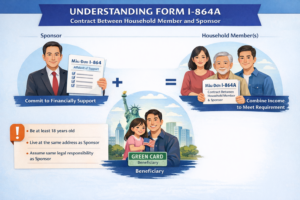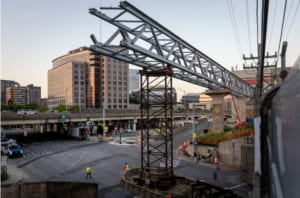
When people think of U.S. immigration, the first thing that comes to mind oftentimes is Lawful Permanent Residence (“Green Card.”) However, the journey to permanent residency is not a one-size-fits-all road.
The Green Card system can be divided into several visa categories, each with its own purpose, requirements, and process. Knowing how these categories differ is a must and making the right choice may shorten waiting times, avoid unnecessary setbacks, and help immigrant visa applicants and their families achieve their long-term goals.
In 2025, the United States Citizenship and Immigration Services (“USCIS”) rolled out updates that streamlined certain steps while adding new layers of review in others. In this article, we will walk through the three main options: family-based; employment-based; and investment-based immigrant visas, enabling you to understand the differences and see where recent changes may affect your path forward.
The Main Types of U.S. Immigrant Visas
There are several pathways open to foreign nationals leading to a Green Card. While there are many specific immigrant visa categories, most fall into the following groups:
Family-Based Immigrant Visas
1. Immediate Relative Category (IR/CR)
This group covers the closest family members of U.S. citizens, such as spouses, unmarried children under twenty-one (21), and parents which are represented by immigrant visas such as IR1, IR2, IR5, CR1, and CR2.
- No annual visa quota, which means visas are always available.
- Processing is faster compared to other categories, usually taking 12–30 months.
2. Family-Based Preference Category (FB)
When the relationship falls outside the “immediate relative” definition, applicants move into the family preference system. This includes F1, F2A, F2B, F3, and F4 visas.
- Annual quotas apply, which creates long waiting lists.
- Processing times vary widely, ranging from 2 to 25 years depending on the category and the applicant’s nationality.
Employment-Based U.S. Immigrant Visa Categories (EB)
The employment-based (EB) system creates opportunities for individuals whose skills, expertise, or investments contribute directly to the U.S. economy. These visas are divided into five main categories:
- EB-1: For individuals with extraordinary ability, multinational executives, and outstanding professors or researchers.
- EB-2: For professionals holding advanced degrees or demonstrating exceptional ability in their field.
- EB-3: For skilled workers, professionals such as nurses and healthcare workers, and in some cases, other workers such as unskilled workers filling labor shortages.
- EB-4: For religious workers and other “special immigrants,” such as certain broadcasters, translators, and international employees of the U.S. government.
- EB-5: For investors who make a qualifying investment in the U.S. that creates at least ten (10) American jobs.
Across all categories, the emphasis is on meeting U.S. needs through talent or capital.
- Skill and investment are the priorities: EB-1 through EB-4 focus on professional contributions, while EB-5 is based on financial investment.
- EB-5 requires significant capital: Investments range from US$800,000-1,050,000, depending on the project location.

Visa Quotas and Processing Times for U.S. Immigrant Categories
Most immigrant visas are numerically limited each fiscal year. For 2025, the family-based sponsored worldwide limit is 226,000, and the employment-based worldwide limit is at least 140,000.
There’s also a per-country cap of seven-percent (7%) of the combined family + employment totals, which is why high demand countries (e.g., India, China, Mexico, Philippines) have visa backlogs also known as retrogression.
The Visa Bulletin published by the United States Department of State shows:
- Final action dates: When immigrant visas or green cards can actually be issued (“current” means no queue).
- Dates for filing: These dates are used to alert applicants that they can begin their visa application or adjustment of status processing. The USCIS announces each month which chart (final action vs. dates for filing) applicants must use for adjustment filings.
Your place in line is set by your priority date (usually the petition filing date, or the permanent labor certification filing date for cases needing labor certification).
If the priority date is earlier than the cutoff in the current Visa Bulletin, you can move forward; if not, you wait until the category/country becomes current.
2025 Queue Snapshot (Aug 2025 Visa Bulletin)
Below are examples of Final Action Dates (the “real” queue) as of August 2025. These don’t equal exact wait times, but they show how far the line has progressed.
| Category (sample) | Chargeability | Final Action Date (Aug 2025) | What it implies |
| F2A (Spouse/child of LPR) | Worldwide | 01‑Sep‑2022 | There’s a queue; cases with PD before Sept 1, 2022 can be approved now. |
| F4 (Siblings of U.S. citizens) | Philippines | 01‑Jan‑2006 | Illustrates very long family backlogs for PH; filing today means a long wait. |
| EB‑1 (Priority workers) | Most countries | Current | Often the fastest EB path when “current”; China/India have cutoffs. |
| EB‑1 | China | 15‑Nov‑2022 | China remains backlogged in EB‑1. |
| EB‑1 | India | 15‑Feb‑2022 | India remains backlogged in EB‑1. |
| EB‑2 (Advanced degree/exceptional ability) | Most countries | 01‑Sep‑2023 | Modest queue for ROW; longer for China/India. |
| EB‑3 (Skilled/professional) | Most countries | 01‑Apr‑2023 | Demand is high; DOS warned of possible Sept retrogression/unavailability. |
| EB‑5 (Unreserved) | India | 15‑Nov‑2019 | Backlog persists in unreserved. Set‑aside lanes are “current.” |
| EB‑5 (Rural/High‑Unemp/Infra Set‑Asides) | All | Current | The 32% reserved visas under RIA remain current as of Aug 2025. |
Notes: EB‑5 set‑asides = 20% Rural, 10% High‑Unemployment, 2% Infrastructure. These reserved lanes can significantly shorten waits compared with unreserved EB‑5 in high‑demand countries.
Comparative “Time to Green Card” in 2025 (Estimates)
Exact timelines vary with USCIS service center workloads, security checks, and local consulate capacity. If a category is current, many applicants can complete the full journey in roughly 1 to 2 years (USCIS petition + National Visa Center + Interview/ Adjustment).
If a category has a cutoff date, add the queue time implied by the Visa Bulletin to those processing steps.
*Estimates reflect 2025 conditions and the August 2025 Visa Bulletin. Always check the current month’s charts and USCIS filing guidance.
Which Category Is Fastest Right Now?
- Immediate Relatives (IR/CR) of U.S. citizens are typically the fastest because they are not subject to annual caps. Timelines hinge mainly on case processing.
- EB‑1 for most countries is often fast when “current” (as it is in Aug 2025), while EB‑2/EB‑3 vary by country and can slow if retrogression occurs.
- EB‑5 set‑aside categories (Rural/High‑Unemployment/Infrastructure) are current as of August 2025, making them significantly faster than unreserved EB‑5 for India/China.
We at Enterline and Partners can tailor this section with a Philippines, Vietnam, and Taiwan and Asia specific snapshot, using the latest Visa Bulletin cutoffs to show realistic expectations. Get in touch with us today.

Answering Common Questions About U.S. Immigrant Visa Categories
Sorting through U.S. visa options can feel overwhelming, and it’s normal to have questions or concerns. Below, we have answered some of the most common ones people ask about family, employment, and investment visas, so you can see how the rules apply in real situations.
What’s the difference between IR1 and CR1?
Both IR1 and CR1 are spousal visas for the husband or wife of a U.S. citizen. The distinction is based on how long you have been married at the time your visa is approved.
If the marriage is more than two (2) years old, you receive an IR1 visa and a ten (10)-year Green Card. If the marriage is less than two years old, you receive a CR1 visa and a two-year conditional green card, which later requires filing to remove conditions ninety (90) days prior to the two-year anniversary of arriving in the United States.
Can you switch between visa categories?
In some situations, yes. For instance, if you applied under the family preference system as the spouse of a permanent resident and your sponsor becomes a U.S. citizen, your case can be upgraded to the immediate relative category, which often shortens the waiting time.
Employment-based applicants may also shift to another EB category if their qualifications or circumstances change, but this usually requires a new petition or formal request rather than happening automatically.
Which visa is suitable for applicants with no relatives in the United States?
For those without qualifying family ties, the main pathways are through employment or investment. Employment-based visas, such as EB-1, EB-2, or EB-3, are available to individuals with job skills, advanced education, or employer sponsorship.
Another option is the EB-5 investor visa, which allows applicants to gain permanent residency by making a qualifying investment in a U.S. business that creates jobs.
Finding Your Best Path Forward in U.S. Immigration
Understanding how each visa category applies to your situation (and how recent USCIS updates in 2025 may affect eligibility) can make all the difference in achieving permanent residency.
But regardless of the visa most applicable to you, professional guidance is essential. With experienced support from our immigration lawyers, applicants can reduce delays, anticipate challenges, and choose a pathway that fits both immediate needs and long-term plans.
For Vietnamese nationals, especially, 2025 brings encouraging opportunities under the EB-5 and EB-3 programs. These categories offer practical routes to a Green Card while contributing to the U.S. economy through investment and skilled employment. At Enterline and Partners, we provide personalized strategies and hands-on support, backed by decades of experience in U.S. immigration law. If you’re considering your next steps, now is the right time to connect with our team and explore the path that leads you closer to your Green Card!
ENTERLINE & PARTNERS CONSULTING
Ho Chi Minh City, Vietnam Office
146C7 Nguyen Van Huong St, Thao Dien Ward,
District 2, Thu Duc City
Ho Chi Minh City, Vietnam
Tel: +84 933 301 488
Email: info@enterlinepartners.com
Facebook: Enterline & Partners – Dịch vụ Thị thực và Định cư Hoa Kỳ
YouTube: @EnterlineAndPartnersConsulting
Website: http://enterlinepartners.com
Manila, Philippines Office
LKG Tower 37th Floor
6801 Ayala Avenue
Makati City, Philippines 1226
Tel: +63 917 543 7926
Email: info@enterlinepartners.com
Facebook: Enterline and Partners Philippines
Website: https://enterlinepartners.com/language/en/welcome/
Copyright 2025. This article is for information purposes only and does not constitute legal advice. This article may be changed with or without notice. The opinions expressed in this article are those of Enterline and Partners only.




